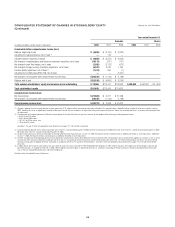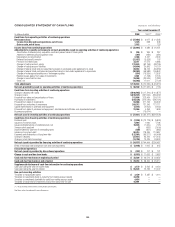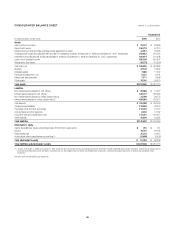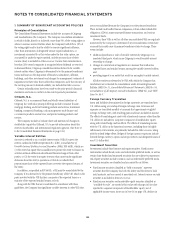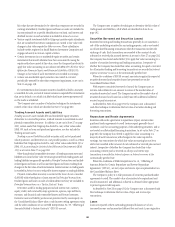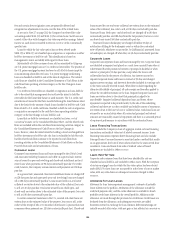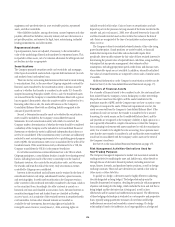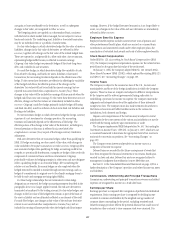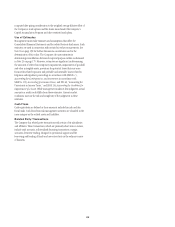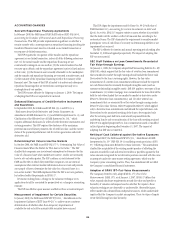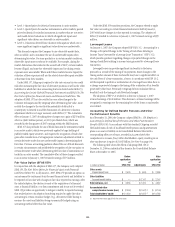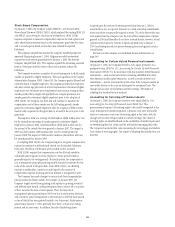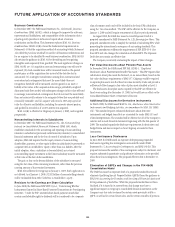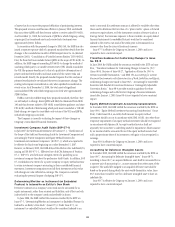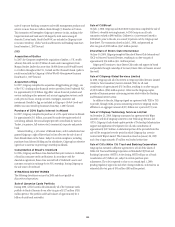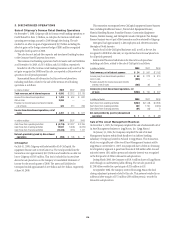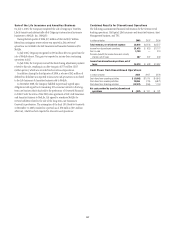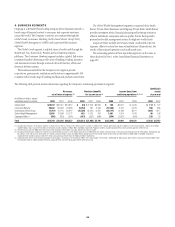Citibank 2008 Annual Report Download - page 135
Download and view the complete annual report
Please find page 135 of the 2008 Citibank annual report below. You can navigate through the pages in the report by either clicking on the pages listed below, or by using the keyword search tool below to find specific information within the annual report.ACCOUNTING CHANGES
Sale with Repurchase Financing Agreements
In February 2008, the FASB issued FASB Staff Position (FSP) FAS 140-3,
Accounting for Transfers of Financial Assets and Repurchase Financing
Transactions. This FSP provides implementation guidance on whether a
security transfer with a contemporaneous repurchase financing involving the
transferred financial asset must be evaluated as one linked transaction or
two separate de-linked transactions.
The FSP requires the recognition of the transfer and the repurchase
agreement as one linked transaction, unless all of the following criteria are
met: (1) the initial transfer and the repurchase financing are not
contractually contingent on one another; (2) the initial transferor has full
recourse upon default, and the repurchase agreement’s price is fixed and not
at fair value; (3) the financial asset is readily obtainable in the marketplace
and the transfer and repurchase financing are executed at market rates; and
(4) the maturity of the repurchase financing is before the maturity of the
financial asset. The scope of this FSP is limited to transfers and subsequent
repurchase financings that are entered into contemporaneously or in
contemplation of one another.
The FSP becomes effective for Citigroup on January 1, 2009. The impact
of adopting this FSP is not expected to be material.
Enhanced Disclosures of Credit Derivative Instruments
and Guarantees
In September 2008, the FASB issued FSP FAS 133-1 and FIN 45-4,
“Disclosures about Credit Derivatives and Certain Guarantees: An
Amendment of FASB Statement No. 133 and FASB Interpretation No. 45, and
Clarification of the Effective Date of FASB Statement No. 161,” which
requires additional disclosures for sellers of credit derivative instruments and
certain guarantees. This FSP requires the disclosure of the maximum
potential amount of future payments, the related fair value, and the current
status of the payment/performance risk for certain guarantees and credit
derivatives sold.
Determining Fair Value in Inactive Markets
In October 2008, the FASB issued FSP FAS 157-3, “Determining Fair Value of
Financial Assets When the Market for That Asset is Not Active.” The FSP
clarifies that companies can use internal assumptions to determine the fair
value of a financial asset when markets are inactive, and do not necessarily
have to rely on broker quotes. The FSP confirms a joint statement by the
FASB and the SEC in which they stated that companies can use internal
assumptions when relevant market information does not exist and provides
an example of how to determine the fair value for a financial asset in a
non-active market. The FASB emphasized that the FSP is not new guidance,
but rather clarifies the principles in SFAS 157.
Revisions resulting from a change in the valuation technique or its
application should be accounted for prospectively as a change in accounting
estimate.
The FSP was effective upon issuance and did not have a material impact.
Measurement of Impairment for Certain Securities
In January 2009, the FASB issued FSP EITF 99-20-1, “Amendments to the
Impairment Guidance of EITF Issue 99-20,” to achieve more consistent
determination of whether other-than-temporary impairments of
available-for-sale or held-to-maturity debt securities have occurred.
This FSP aligns the impairment model of Issue No. 99-20 with that of
FASB Statement 115, Accounting for Certain Investments in Debt and
Equity Securities. SFAS 115 requires entities to assess whether it is probable
that the holder will be unable to collect all amounts due according to the
contractual terms. The FSP eliminates the requirement to consider market
participants’ views of cash flows of a security in determining whether or not
impairment has occurred.
The FSP is effective for interim and annual reporting periods ending after
December 15, 2008 and applied prospectively. The impact of adopting this
FSP was not material.
SEC Staff Guidance on Loan Commitments Recorded at
Fair Value through Earnings
On January 1, 2008, the Company adopted Staff Accounting Bulletin No. 109
(SAB 109), which requires that the fair value of a written loan commitment
that is marked-to-market through earnings should include the future cash
flows related to the loan’s servicing rights. However, the fair value
measurement of a written loan commitment still must exclude the expected
net cash flows related to internally-developed intangible assets (such as
customer relationship intangible assets). SAB 109 applies to two types of loan
commitments: (1) written mortgage loan commitments for loans that will be
held-for-sale when funded that are marked to market as derivatives under
SFAS 133 (derivative loan commitments); and (2) other written loan
commitments that are accounted for at fair value through earnings under
SFAS 159’s fair-value election. SAB 109 supersedes SAB 105, which applied
only to derivative loan commitments and allowed the expected future cash
flows related to the associated servicing of the loan to be recognized only
after the servicing asset had been contractually separated from the
underlying loan by sale or securitization of the loan with servicing retained.
SAB 109 was applied prospectively to loan commitments issued or modified
in fiscal quarters beginning after December 15, 2007. The impact of
adopting this SAB was not material.
Netting of Cash Collateral against Derivative Exposures
During April 2007, the FASB issued FSP FIN 39-1, “Amendment of FASB
Interpretation No. 39” (FSP FIN 39-1) modifying certain provisions of FIN
39, “Offsetting of Amounts Related to Certain Contracts.” This amendment
clarified the acceptability of the existing market practice of offsetting the
amounts recorded for cash collateral receivables or payables against the fair
value amounts recognized for net derivative positions executed with the same
counterparty under the same master netting agreement, which was the
Company’s prior accounting practice. Thus, this amendment did not affect
the Company’s consolidated financial statements.
Adoption of SFAS 157—Fair Value Measurements
The Company elected to early-adopt SFAS No. 157, Fair Value
Measurements (SFAS 157), as of January 1, 2007. SFAS 157 defines fair
value, expands disclosure requirements around fair value and specifies a
hierarchy of valuation techniques based on whether the inputs to those
valuation techniques are observable or unobservable. Observable inputs
reflect market data obtained from independent sources, while unobservable
inputs reflect the Company’s market assumptions. These two types of inputs
create the following fair value hierarchy:
129


